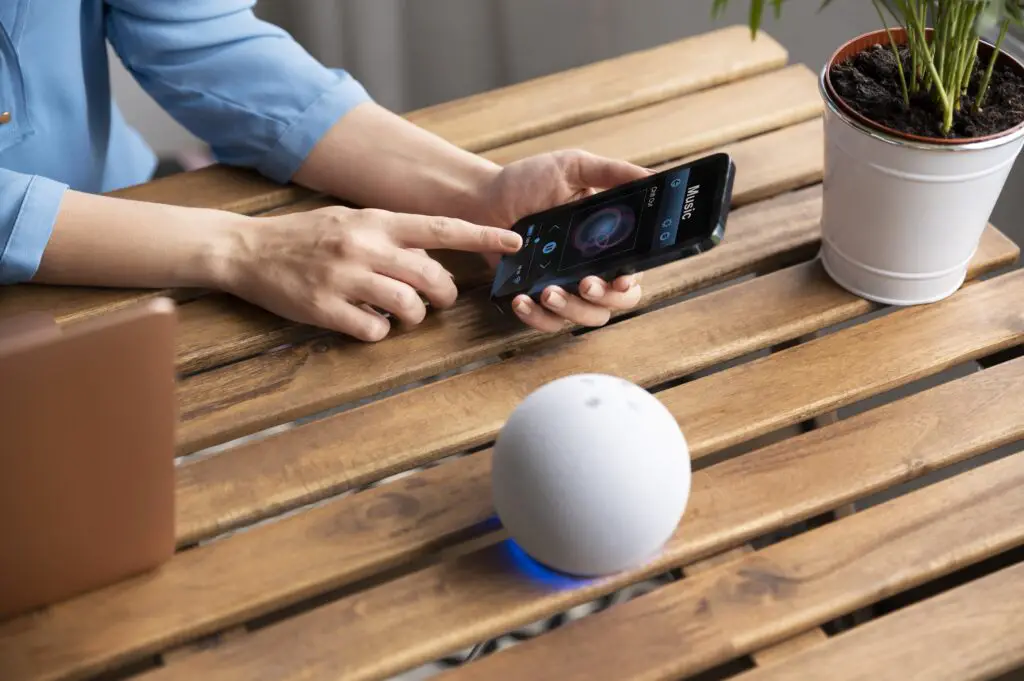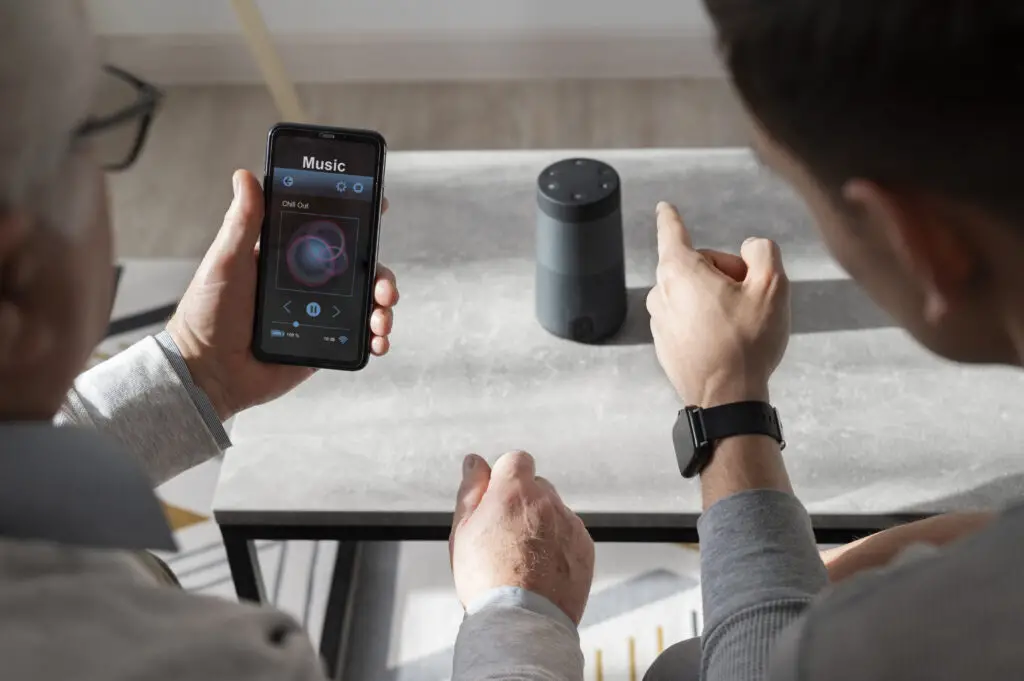You’re juggling dinner prep, your phone’s buzzing, and the kids are asking for their favorite playlist. Instead of fumbling with switches or apps, you simply say, “Hey Google, dim the kitchen lights, play some jazz, and lock the front door.” In seconds, your home transforms—lights soften, music fills the air, and your IoT door lock clicks shut. This is the magic of voice assistants in 2025, where natural language commands turn your smart home into a responsive, intuitive haven. With devices like the Amazon Echo (5th Gen), Google Nest Hub Max, and Home Assistant Voice Preview Edition, voice assistants are smarter, more privacy-focused, and deeply integrated into daily life. The global smart speaker market is projected to reach 111.1 million users in the US alone this year, growing at a 3.3% YoY rate, per emarketer.com. Let’s explore how voice assistants work, spotlight top devices for 2025, and uncover why they’re the key to seamless, hands-free home control.
The Voice Assistant Revolution: Your Home’s New Brain
Picture your smart home as a symphony, with lights, locks, thermostats, and cameras as instruments. Voice assistants are the conductors, using artificial intelligence (AI), natural language processing (NLP), and speech recognition to interpret your spoken commands and orchestrate your devices, per hassanable.com. Unlike traditional interfaces like keypads or apps, voice assistants let you control your home with conversational phrases, making them accessible for everyone—from kids to seniors, per staysafe.org.
Here’s what makes voice assistants in 2025 stand out:
- Natural Language Understanding: Improved NLP handles complex, context-aware commands like “Turn off all lights except the bedroom,” per hassanable.com.
- Smart Home Integration: Connects with IoT devices (e.g., locks, lights, thermostats) via platforms like Matter, Alexa, or Google Home, per theverge.com.
- Privacy Focus: Edge AI processes commands locally for faster, more private responses, per home-assistant.io.
- Multitasking: Execute multiple actions with one command, like setting lights and music, per refinedsystems.com.
- Accessibility: Hands-free control aids those with mobility issues, per outsourceaccelerator.com.
On X, @csaiot highlights the Yale Smart Lock’s Matter compatibility, enabling control via Alexa, Google, or Apple Home with natural commands, per @csaiot. For you, this means a home that responds effortlessly to your voice, whether you’re adjusting the thermostat or securing your IoT door lock, per our IoT door locks article.
Top Voice Assistants for 2025: Your Command Central
Here’s our curated lineup of the best voice assistants and smart speakers for 2025, chosen for their intelligence, compatibility, and value, based on recent industry updates and testing.
1. Amazon Echo (5th Gen)
- Price: $99
- Specs: 2K audio, Wi-Fi 6E, Matter/Thread hub, 3-inch woofer, Alexa AI+ (optional $19.99/month for Prime members).
- Features: AI-driven routines, person detection with Alexa+, smart home control, multi-room audio, no subscription for basic features.
- Why It’s a Winner: Launched in 2024, the Echo 5th Gen offers rich sound and seamless control of IoT devices like the Schlage Smart WiFi Deadbolt, per ahs.com. Its Alexa+ upgrade adds image analysis and automated routines, per emarketer.com. @iotguide praises its “proactive intelligence” for suggesting routines, per @iotguide.
- Your Win: Say “Alexa, set movie night” to dim lights, lock doors, and play a playlist, ideal for Amazon ecosystem fans.
2. Google Nest Hub Max
- Price: $229
- Specs: 10-inch 2K display, 30W stereo speakers, Google Assistant with Gemini AI, Matter support, sleep tracking.
- Features: Face Match, live camera feeds, multi-device control, Google Photos integration.
- Why It’s a Winner: Its 10-inch screen doubles as a photo frame and security hub, displaying feeds from AI-powered cameras, per wired.com. Gemini AI enhances context-aware responses, per hassanable.com. @csaiot notes its Matter compatibility for seamless control, per @csaiot.
- Your Win: Say “Hey Google, show the front door” to view your Reolink camera, perfect for Google Home users.
3. Home Assistant Voice Preview Edition
- Price: $99
- Specs: Local processing, ESPHome 2025.5.0, 3.5mm audio port, Grove sensor port, Speech-to-Phrase for low-power devices.
- Features: Fully local AI, customizable wake words, multilingual support, no cloud dependency.
- Why It’s a Winner: Launched in 2024, it prioritizes privacy with local speech processing, per home-assistant.io. Supports custom commands and works with Raspberry Pi or ATOM Echo, per home-assistant.io. @smarthomecircle highlights its 2025.7 updates for natural conversations, per @smarthomecircle.
- Your Win: Say “OK Nabu, turn off kitchen lights” for private, customizable control, ideal for DIY enthusiasts.
4. Apple HomePod 2
- Price: $299
- Specs: 4K audio, 5 tweeters, Siri with Apple Intelligence, Matter/Thread, room-sensing audio.
- Features: Auto-optimizing audio, HomeKit integration, temperature/humidity sensors.
- Why It’s a Winner: Its room-adaptive audio adjusts for placement, delivering crisp sound for music or commands, per whathifi.com. Siri’s 21-language support suits bilingual homes, per bestbuy.com.
- Your Win: Say “Siri, lock the front door” to secure your Yale Smart Lock, great for Apple ecosystem users.
5. Echo Hub
- Price: $179
- Specs: 8-inch 2K touchscreen, Wi-Fi 6E, Matter/Thread/Zigbee hub, Alexa AI+, wall-mountable.
- Features: Visual control, smart home dashboard, person detection, no music focus.
- Why It’s a Winner: Designed as a smart home control panel, it integrates with IoT locks and cameras, per wired.com. Its touchscreen complements voice commands, per ahs.com.
- Your Win: Say “Alexa, arm security” to activate cameras and locks, perfect for centralized control.
Why Voice Assistants Transform Your Home
Voice assistants make home control effortless and intuitive:
- Hands-Free Convenience: Control lights, locks, or thermostats without touching a device, ideal for multitasking, per refinedsystems.com.
- Natural Commands: Say “Turn on the living room lights” instead of scripted phrases, thanks to advanced NLP, per hassanable.com.
- Smart Home Integration: Seamlessly manage IoT devices like Eufy locks or Philips Hue lights via Matter, per theverge.com. @csaiot notes Matter’s multi-platform support, per @csaiot.
- Accessibility: Hands-free operation aids those with mobility issues, per outsourceaccelerator.com.
- Privacy Options: Local processing (Home Assistant) minimizes cloud data, per home-assistant.io.
- Energy Efficiency: Automate lights and thermostats to save 10–20% on energy bills, per eshop.se.com.
For you, this means a home that responds to your voice like a trusted assistant, whether you’re setting the mood for movie night or securing your door, per our AI-powered security cameras article.

Choosing Your Voice Assistant: Tips for a Smart Home
Selecting the right voice assistant depends on your setup:
- Ecosystem: Choose Alexa (Echo) for Amazon, Google Assistant (Nest Hub) for Android/Google, or Siri (HomePod) for Apple, per bestbuy.com.
- Privacy: Opt for Home Assistant for local processing or Alexa with voice profile restrictions, per lindy.ai.
- Features: Echo Hub for visual control, HomePod for audio quality, or Nest Hub for camera feeds, per wired.com.
- Budget: Echo Dot ($49) for affordability, HomePod 2 ($299) for premium sound, per whathifi.com.
- Compatibility: Ensure Matter or Thread support for IoT devices like Yale locks, per @csaiot.
Pro Tip: Test Wi-Fi strength with apps like Wi-Fi Analyzer to ensure reliable connectivity, and use 5G/Wi-Fi 7 routers for future-proofing, per our Wi-Fi 7 routers article.
Challenges to Consider
- Privacy Concerns: Cloud-based assistants (Alexa, Google) may store voice data; opt for local processing (Home Assistant) or disable always-listening, per coram.ai. Review settings, per our GDPR Policy.
- Connectivity: Wi-Fi-dependent assistants need strong signals; offline features are limited, per refinedsystems.com.
- Cost: Premium devices like HomePod 2 ($299) or subscriptions (Alexa+, $19.99/month) add up, per emarketer.com.
- Accuracy: Accents or noisy environments can confuse assistants, per umatechnology.org.
- Compatibility: Some devices require specific ecosystems (e.g., HomeKit for Siri), per bestbuy.com.
GadgetShaker recommends checking device compatibility and prioritizing local processing for privacy, per TechRadar.
The Future of Voice Assistants
By 2030, voice assistants will evolve:
- AI Advancements: Predictive analytics will anticipate needs, like locking doors at night, per oyelabs.com.
- 6G Integration: Faster networks will enhance real-time control, per our 5G article.
- Aliro Standard: Cross-platform NFC/UWB unlocking, per theverge.com.
- Eco-Friendly Designs: Low-power hardware, per our sustainable laptops article.
For you, expect voice assistants that are smarter, faster, and greener, making home control effortless.
GadgetShaker’s Picks: Your Voice-Controlled Future
We’ve tested voice assistants to find your ideal hub. The Amazon Echo (5th Gen) leads for its affordability and Alexa+ features, while Home Assistant Voice Preview Edition is best for privacy-focused DIYers. Questions about Nest Hub Max or HomePod 2? Drop them on our Contact Us page or comment below! Look out for guides like “Best Voice Assistants for Smart Homes in 2025” or “How to Set Up a Voice-Controlled Home.”
Final Thoughts: Your Home, Your Voice
Voice assistants in 2025, like the Amazon Echo, Google Nest Hub Max, and Home Assistant Voice Preview Edition, bring seamless home control with natural commands. With AI-driven NLP, Matter integration, and privacy options, they manage lights, locks, and more with ease. Despite challenges like privacy and connectivity, their impact is transformative. Stay connected with GadgetShaker.

